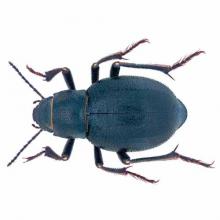Sternoplax zichyi
Common name:
Darkling beetle
Genus:
Sternoplax
Family:
Tenebrionidae
Suborder:
Polyphaga
Sternoplax zichyi
Common name:
Darkling beetle
Genus:
Sternoplax
Family:
Tenebrionidae
Suborder:
Polyphaga
Sternoplax zichyi
Common name:
Darkling beetle
Genus:
Sternoplax
Family:
Tenebrionidae
Suborder:
Polyphaga
Family (Animalia): Tenebrionidae
Darkling beetle is the common name of the large family of beetles Tenebrionidae. The number of species in the Tenebrionidae is estimated at more than 20,000 and the family is cosmopolitan in distribution.
Taxonomy
Tenebrio is the Latin generic name that Carl Linnaeus assigned to some flour beetles in his 10th edition of Systema Naturae.The word means "seeker of dark places" (or figuratively a trickster); an English language analog is "darkling".
Numerous Tenebrionidae species do inhabit dark places, however, there are many species in genera such as Stenocara and Onymacris, which are active by day and inactive at night.
The family covers a varied range of forms, such that classification presents great difficulties.
The misspelling "Terebrionidae" occurs frequently enough to be easily overlooked. The error appears to have no particular significance, but to be the product of misreadings, mis-scans and mis-typings.
The oldest known member of the family is Jurallecula from the Late Jurassic Karabastau Formation of Kazakhstan, assigned to the subfamily Alleculinae.
Characteristics
The Tenebrionidae may be identified by a combination of features, including:
- Their 11-segmented antennae that may be filiform, moniliform or weakly clubbed
- First abdominal sternite is entire and not divided by the hind coxae
- Eyes notched by a frontal ridge
- The tarsi have four segments in the hind pair and five in the fore and mid legs (5-5-4), tarsal claws are simple
Biology and ecology
Tenebrionid beetles occupy ecological niches in mainly deserts and forests as plant scavengers. Most species are generalistic omnivores, and feed on decaying leaves, rotting wood, fresh plant matter, dead insects, and fungi as larvae and adults. Several genera, including Bolitotherus, are specialized fungivores which feed on polypores. Many of the larger species are flightless, and those that are capable, such as T. molitor, only do so when necessary, such as when dispersing or malnourished.
The larvae, known as mealworms or false wireworms, are usually fossorial, heavily armored and nocturnal. They may possibly be an important resource for certain invertebrates and small mammals. However, the adults of many species have chemical defenses and are relatively protected against predators. Adults of most species, except grain pests, have slow metabolisms, and live long lives compared to other insects, ranging from approximately six months to two years.
Some species live in intensely dry deserts such as the Namib, and have evolved adaptions by which they collect droplets of fog that deposit on their elytra. As the droplets accumulate the water drains down the beetles' backs to their mouthparts, where they swallow it.
Humans spread some species such that they have become cosmopolitan, such as Tribolium castaneum, the red flour beetle, which was spread through grain products.
Reference: Wikipedia

